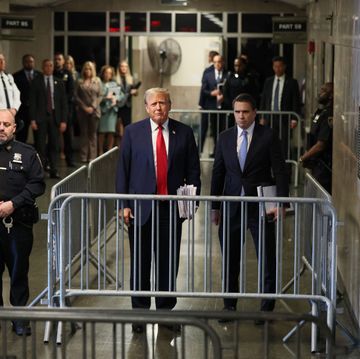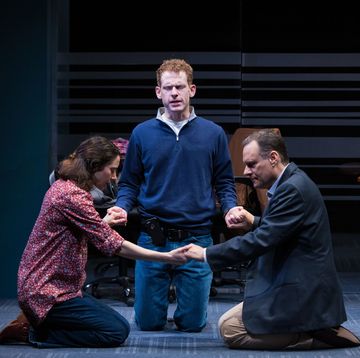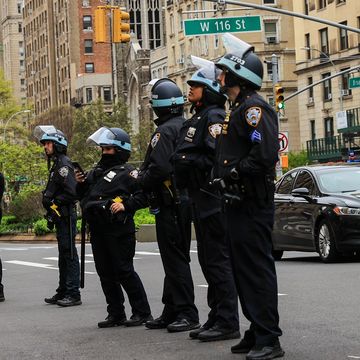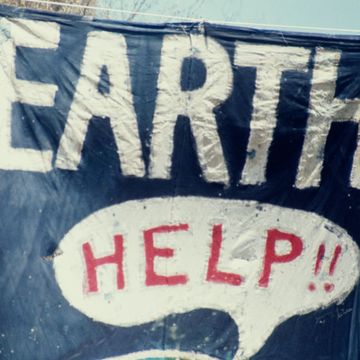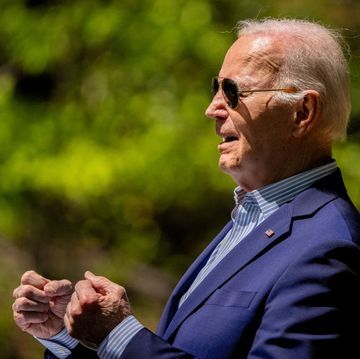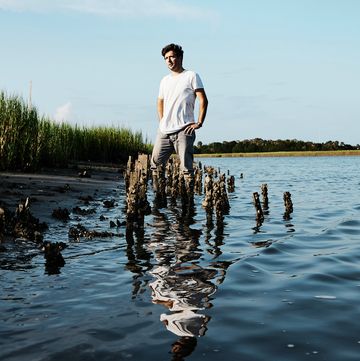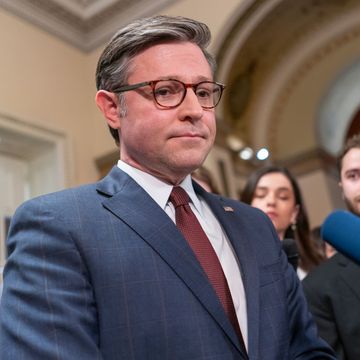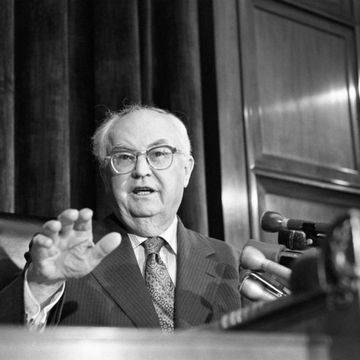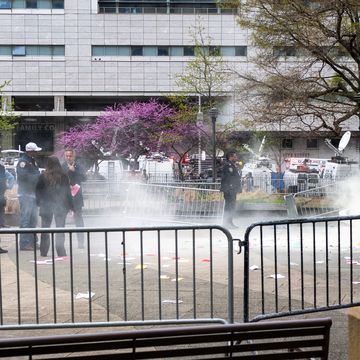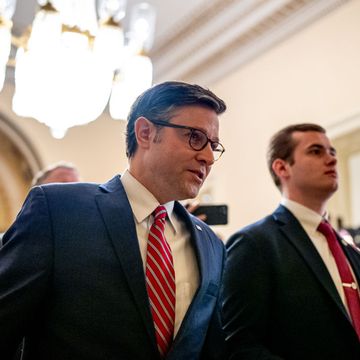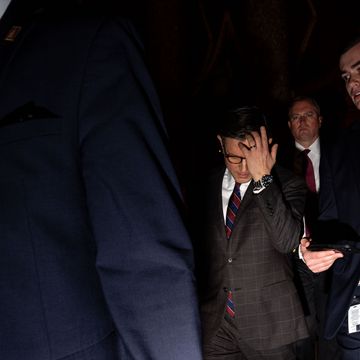The videographer is scrambling. He missed the shot. It's not his fault, really. The moment was spontaneous, unexpected. That was the whole point. But those moments are, by their nature, impossible to anticipate and easy to miss.
So he's scrambling, pushing his way through a dense crowd of men in dour gray suits and women in multicolored saris, trampling the pastel flower petals that the children carpeted the schoolyard with early this morning. He's asking everyone he sees with a camera if they got it, if they managed to snag what slipped away from him. He finds two people, two cameras, retreats with them to the backseat of one of the SUVs in the five-vehicle convoy that brought the visitors here, to this ten-letter village, Kollapatti, on the outskirts of a fourteen-letter city, Tiruchirapalli. Soon cables snake from the borrowed cameras to the USB ports on his MacBook. He finds the videos he's looking for and sucks them into his hard drive. He watches them.
The first is from the rear.
The shoulders and nape and back of the head of a man sitting in a classroom, facing a group of children six to ten years old. The man is wearing a navy-blue button-down shirt. The video is pretty high-res, and you can see that the man has a few gray hairs and a tiny mole on the back of his left ear. There are about thirty children in all, and they're all dressed in school uniforms. Some of the children have bindis on their foreheads, and many of the girls have flowers in their hair.
The children are singing. "This is the way we brush our teeth, brush our teeth, brush our teeth. This is the way we brush our teeth, early in the morning." Their right hands are cocked like pantomime guns, index fingers scraping the air in front of their mouths. Then they squat down. "This is the way we go to the toilet, go to the toilet, go to the toilet..." Their voices are loud, you can't hear anything else, but you can tell by the way the back of the man's head bobs and sways and his shoulders hitch that he's laughing.
The song goes on for a few more verses, and the videographer figures he could cut those verses out, as well as most of the question-and-answer session that follows the song. Cut everything. Right up until the little girl stands up. She's maybe eight years old. She looks shy. She's looking at the visitor. "Can you sing a song for us?"
The other shot is from the front.
Matt Damon sitting in a school chair. Two thick leis woven from purple-and-white flowers hanging around his neck. A single yellow flower in his hand. A brown bindi on his forehead. The girl asks the question and he grins at her, begins twirling his flower.
"Okay," he says and starts getting to his feet.
The shot can't show you what's going on in his head, of course. It can't show you the tumble of jet-lagged thoughts, the effort to come up with some song, any song, to sing. He's flashing back to another unexpected request, years ago, in another foreign country, when he was a guest on a Japanese television show. For some reason he's never understood, he'd been asked to judge a whistling contest. And at the contest's end, in a strange encore, he'd somehow wound up coerced into whistling, alongside the finalists, a full-length rendition of "We Are the World."
So here, today, standing in front of a roomful of kids, that's the only song he can think of, and it's almost the song he launches into. But then another song occurs to him, a more appropriate choice. The perfect choice, really.
Which leads us to the moment the videographer missed:
Matt Damon, thirty-eight, in an Indian schoolhouse, squatting like a Russian dancer, waggling his ass and belting out a bathroom ditty — "This is the way we go to the toilet, go to the toilet, go to the toilet, early in the morning" — as his leis shimmy and sweat-smeary bindi ink runs down toward his eyes.
Later, Anthony Abraham, a former Indian special-forces commando who's handling security for the trip, will tell the group that some of the bindi ink, depending on its provenance, could be highly toxic, and they will commence scrubbing their foreheads with Handi Wipes in the searing midafternoon sun, like women exiting an Avon party.
But not now, not yet. Because right now the kids are going wild, hooting and laughing, the whole classroom cracking up. Kids, no matter where they are, love nothing more than the spectacle of an adult making a fool of himself, and Damon's doing so with abandon, throwing himself into the part.
Already the videographer's thinking of ways he might edit this, shape it into a clip. Maybe he'll just fade to black as soon as the moment passes. Throw some text up. Perhaps just the logo: Water.org.
He thinks it could definitely go viral.
The Great Kabab Factory, New Delhi, India. Matt Damon sits, back to the wall, at a long table at the far end of the room. It's midnight here, July 7, 2009. Among the friends at the table is Damon's older brother, Kyle, and somewhere around the fifth round of grilled meats and the fourth round of beer, Kyle starts telling a story from another trip he took with Matt, or Uncle Mattie, as Kyle's kids call him. Uncle Mattie takes them on vacation everywhere. Hawaii, Argentina, Portugal. But not on trips like the one Kyle is talking about.
It was a couple of years ago. They were in a village in Zambia, a remote corner of a remote country. Unpaved streets. No running water. He and Matt were walking around, checking things out, when they happened upon the rural Zambian equivalent of a movie theater. A small mud-brick stall, crammed with plastic chairs. An old thirteen-inch TV and VCR. Admission was ten cents U. S. Near the entrance was a bootleg movie poster advertising one of the features: The Bourne Supremacy.
"We start taking all these photos," Kyle says. "I mean, it was kind of a cool thing: Here's Matt, next to the Bourne picture in Zambia! And then Matt starts going, like" — and now Kyle sits up a little straighter, adopts a mock-earnest tone — " 'Technically, this is illegal...' "
Matt picks up the thread, something the two of them constantly do when they're around each other.
"Sir, I'm placing you under citizen's arrest!" he says.
Kyle jumps back in: "The police will be here any moment!"
Now it's Marc Joubert, a close friend Damon met fifteen years ago, pre — Good Will Hunting: "Where are my residuals?!"
Matt again: "Let's see, you're charging ten cents a viewer. Sir, it's possible that you've made fourteen dollars off of this! I want that money, sir!"
A stranger approaches the table, interrupts the riffing. A teenage boy. He asks Damon where he flew in from, and when Damon tells him Miami, where he lives with his wife and two young daughters, the boy lights up, tells him he lives in Miami, too, and come to think of it, he thinks he remembers seeing Damon's house on a star map or something. Can he take a picture?
The boy has a cell-phone camera. He holds it up, looks at the screen. Puts it down.
"It's too dark," he tells Damon.
Damon slides out of the dim booth, walks out into the light a bit. He's changed out of the jeans and T-shirts — short sleeves over long sleeves — that he wore on the flight and into khakis and a button-down shirt.
The last role he played, a South African rugby player in a Clint Eastwood movie, required him to dye his hair a more Nordic blond and part it to the side, but that movie wrapped a couple of months ago, and now his hair's back to its natural color, dirty blond, and its natural style: short all around, spiked up just a little in front. The boy holds up the phone again and Damon looks into its eye.
While it's perhaps true that most human smiles are atavistic relics, covert signs of aggression, evolutionary cousins to a dog's snarl, Matt Damon's smile, when he chooses to fully deploy it, is different. There's confidence in it, even a bit of swagger, but no oil, no hesitation, just a full-bore coruscation.
That smile, most definitely, is not the smile he gives now.
His upper lip rises a bit. Some teeth show. His eyes engage. It's not unfriendly, this other smile. It's just incomplete, physically and emotionally. It's present but withholding.
But it's clearly enough for the boy, makes his day. He shakes Damon's hand, his own smile brilliant, walks away looking back down at the image on his phone.
Damon knows how to smile as well as anyone on the planet. But he won't fake it, won't give the whole shebang out to every stranger with a camera. He conserves it, preserves it, so whenever the real thing does come out, when he turns it on, ubiquity hasn't whittled it down or leeched it of its oomph.
He walks back to the table with a sort of half-embarrassed look, slides back into the booth next to Gary White, a forty-six-year-old civil engineer from Kansas City, Missouri.
"Again, they wanted your picture instead of mine," White says.
Damon shrugs, raises his shoulders.
"No one's more baffled than me, Gary."
Between January and February of 2007, researchers from Trinity College Dublin stalked the commuter-rail stations in the heart of the city, brandishing questionnaires. They eventually pigeonholed one hundred respondents, fifty men and fifty women. The questionnaires were short and consisted of six questions in all:
1. Can you think of any celebrities associated with international aid work?
2. What are they each trying to achieve?
3. How much do you think they know about international aid and development?
4. Do they influence you?
5. What is the value of them being involved in this sort of thing?
6. Who benefits from celebrities being involved in this work?
The data from the questionnaires was eventually tabulated, transformed into a series of bar graphs, and interpreted in an academic paper published last December in The International Journal of Nonprofit and Voluntary Sector Marketing. The authors of the paper summed up their findings as follows: "The respondents were fairly cynical as to the motives of most celebrities, whose involvement they felt served their own aims, namely publicity, first and foremost... They respected celebrities they felt were genuinely committed to the causes they espoused, but paradoxically, they felt such commitment was best demonstrated by the celebrity keeping a low profile, and not actively seeking publicity."
Only one of those commuter-rail-riding Dubliners brought up Matt Damon's name, five times fewer than the number who cited Ginger Spice, and well behind Bono and Angelina at the top. He has, so far, been more reticent than the Bonos and Angelinas of the world, or even the Clooneys and the Pitts, when it comes to publicly spending his celebrity capital on the causes he supports.
But his reticence is waning.
He's been famous for twelve years now, a superstar for half that. He's had to come to terms with what it means to live under scrutiny as hot and scouring as a sandstorm.
As Damon puts it, "If you're fucking a goat, you're going to get caught."
He also knows that the sorts of charity appeals that worked in the past — campaigns centered on pictures of starving children with distended bellies, for example — no longer pack the same punch they once did. Like it or not, we're more likely to listen to a plea about land mines in Darfur from Don Cheadle than from a one-legged Darfuri.
So he figures he might as well get caught doing something he believes in.
Room 428, the Taj Hotel, Hyderabad. It's a few minutes after 5:00 P.M. Damon's been in India for three days. In that time he's visited two slums and three villages and met with dozens of municipal bureaucrats and NGO officials. There hasn't yet been time for lunch, just early-morning coffee, followed by a full day's worth of appointments and air travel, a late dinner, and mostly jet-lagged, sleep-starved nights.
But now a break.
The TV's on. The Scripps National Spelling Bee. The bee took place three months ago, but you look at the contestants and it's no surprise that Indian television would rerun it. It's the thirteenth round, three kids left, and the words have become ridiculous.
"Bouquiniste," the bee's official reader intones.
Damon's standing in front of the bed, remote in hand. His brother, Kyle, an artist and a triathlete, is stretched out on the bed with a copy of Freakonomics. They've always been close, and their kinship extends to a mutual interest in activism. It was bred into them, basically. Their mom's a prominent early-childhood-education expert who's always been an active supporter of various causes. One of Kyle and Matt's regular babysitters was a neighbor, Howard Zinn, author of A People's History of the United States. Matt gives bouquiniste a go, is off by two or three letters.
Kavya Shivashankar, thirteen years old, nails it.
Damon shakes his head, flicks off the TV, calls room service, orders a couple of beers.
Damon's a sharp guy. You spend any time at all with him, you figure that out right away. Like, if the two of you are in the village of Kothampatti and a bunch of women you've never met before are explaining some complicated cinder-block-manufacturing co-op they launched to take advantage of a recent toilet-building boom, and after a while your notes get mixed up and you can't remember how much profit the women are making per cinder block, and how much longer it'll be till they've paid off their cinder-block-making-machine loan, you can just ask Damon. He's not even taking notes, but he remembers. One rupee. Fourteen months.
So yeah, he's sharp. And he's probably pretty good at spelling. But he's not a Speller. To be a Speller, you've got to make spelling a full-time job. Little Kavya, she probably spends as much time with her dictionary as she does with her friends.
It kind of goes back to something Matt and Kyle were talking about earlier. The house they grew up in, this big six-family post-hippie co-op in Cambridge, Massachusetts, was the type of place where the residents insisted on doing everything for themselves. Like, if the house needed rewiring, instead of calling an electrician, one of the guys in the house would go to the library, find some Time-Life how-to books, try to do it himself. Which for Kyle and Matt meant growing up in a house where half the switches they flicked didn't do anything, and the other half they never knew if up meant on or vice versa.
The two have a hard-earned appreciation for expertise. It doesn't matter what the subject is. You can be as sharp as anything, but mastery takes time and effort. You want to fix a wiring problem, you call somebody who really knows what they're doing. You want to fix a world water crisis, ditto.
In early 2006, Damon was approached to help out on a documentary, Running the Sahara, about three ultramarathoners who hoped to accomplish the film's eponymous task. Damon signed on as one of the film's executive producers, then founded the H20 Africa Foundation to raise money for water projects along the runners' route.
The H20 Africa Foundation quickly established itself as a well-marketed upstart in the water sector, skilled at leveraging Damon's fame to raise major donations. But on its own, it was also entirely useless. It was never a full-service charity, one that actually did on-the-ground work. What it did instead was funnel the money it raised to a variety of other charities, and those other charities would put the money to work, some more effectively than others.
H20 Africa was also hobbled, in some ways, by the very thing that kick-started it — Damon's stardom. It began as a spin-off of a film project. The chairman of the board of the foundation was Jim Van Eerden, Running the Sahara's other executive producer. He had plenty of Hollywood experience but virtually no water-sector expertise, and he never traveled to see where any of H20 Africa's money actually went. People close to the foundation worried that he might have been in it more to give himself access to Damon than to give children access to water.
Damon never considered himself an expert on water issues, and he still doesn't. He's an actor. But he's a sharp actor. He talked to a lot of people. Did a lot of research. Got a lot of advice.
And then, not long ago, he made a decision. One of the results of the decision is that the H20 Africa Foundation no longer exists.
After they finish their beers, Kyle and Matt head down to the lobby bar, where they meet up with Marc Joubert and Gary White. Clouds of mosquito spray billow through muggy gardens outside, lap against the windows of the bar. Kyle raises a glass to White.
"Gary," he says, "I want you to know that Matt's been looking for somebody like you for a very, very long time."
White responds, as he always does, earnestly. "I'm just glad that Matt and I have a chance to work together toward a common goal."
Damon leans back, cocks an eyebrow. "I'm really excited to bring Lucy along on our next trip so this all seems less gay."
"I could introduce Lucy to Becky," White offers.
"Our beards!" Matt says.
"Why don't you bring Ben?" Kyle tells his little brother. "So it's just extra gay. Supergay!"
And Matt laughs. But he never denies what Kyle said in his toast.
Watch him break a coconut.
Ganesh, the elephant god, loved coconuts, so if a guest smashes a coconut on your front stoop, you follow the logic of religion and count it an auspicious act, a harbinger of good tidings, a sacrificial offering of the mildest sort.
It's early in the morning, the Anna Nagar slum in Hyderabad. Damon is in front of an aqua-colored home the size of a walk-in closet, laundry hanging on a line to dry above his head, a mixture of journalists and colleagues and friends and residents and activists and bureaucrats and security men all around him. The cameras are rolling. A woman in a house on the other side of this street not much wider than Damon's arm span reaches out and thrusts a coconut into his hands.
He takes the coconut, kneels by the concrete stoop. Rolls the coconut one-handed so its eyes are down, its weakest point wide open to the ground. Shirtsleeves rolled up, forearms exposed. The rugby player's muscles haven't all faded away yet. They twitch, and the coconut descends.
This is perhaps the sixth coconut Damon's been asked to smash in the last twenty minutes. The mechanics of it, the plan of attack, have changed a bit over time. At first he was tentative. Then he was too rough, brought the coconuts down too hard. The shells would shatter in a single hit, like bombs, and milk would splash all over him, onto his shirt, down his neck, a sticky glaze on a sticky day.
Now: two quick hits. The first opens a seam, the milk begins to flow. The second finishes the job. A tumult of cheers and claps. Somebody says, "Come, come," in a clipped Indian accent and Damon stands and follows Gary White as the throng moves farther down the street.
He had to feel things out, the strength of the shell, his own strength, what it took to get the job done without getting doused.
The videographer needs more than just the spontaneous stuff, obviously. He needs the standard shots, too. The look-into-the-camera-and-explain-why-you're-here stuff. The tell-don't-show shots. He might not like shooting these sorts of shots, might describe them disparagingly as "kind of the Angelina Jolie thing," but that doesn't mean he doesn't need them, doesn't know they're necessary. He used to be the marketing manager for the Bluetooth consortium, knows that promoting anything requires multiple levels of messaging, not all of which can be of the viral, opaque type. So he stands them up, the movie star and the engineer, in the middle of the alley-wide street of a slum, and he rolls tape.
Look at them.
They're dressed almost the same. Button-down short-sleeved shirts, khakis, sturdy leather boots, chunky watches. The engineer's watch, of course, is digital, and the movie star's analog, but other than that, their outfits are almost identical. Identical and worn in completely different ways. Take their shirts. The engineer's, red checked, is tucked in, a brown belt cinching it tight, the cap of a cheap ballpoint pen peeking out of its pocket. The movie star's, robin's-egg blue, is untucked, loose, nothing in the pocket, top two buttons unbuttoned, neckline sub-clavicle. The effect is night and day, black and white, movie star and engineer.
Marc Joubert introduced Matt Damon to Gary White a little more than a year ago, in New York City. During their first conversation, White explained an idea he'd been gestating, an idea that represented the fruition of an entire adult life spent grappling with the world water crisis. White thought it could potentially change millions of lives, if word got out, if it caught on. Damon really liked the idea. And he liked White's overall vision for WaterPartners, the charity White founded twenty years ago. It had all the expertise and efficacy that H20 Africa lacked, and its reach was greater, spanning to Asia and Latin America as well.
He and White talked for a long time that night, and they stayed in touch, and eventually they came to a mutual decision. A proposal was drafted and presented to the boards of their respective charities. A couple board members at H20 Africa balked, but Damon made it clear that either his proposal flew or he would.
Three months ago, following unanimous votes by both boards, H20 Africa merged with WaterPartners International. Their identities melded, and their old names fell away, replaced by a brand new one: Water.org. This trip to India is a sort of honeymoon, in fact, or even a wedding ceremony, a way to announce their union to the world.
Now watch them talk.
A black goat forages in the narrow street behind them. Green-and-aqua concrete walls bear the faded tatters of old political posters. White has his hands on his hips, posture stiff. Damon has his left elbow crooked casually, hand covering his navel. White does most of the talking, though Damon guides the conversation, asking the questions. White's big idea emerges.
Until recently, the people living in this slum, the men, women, and children in the dark hovels with bright exteriors, had to spend hours every day walking and waiting in long lines at public taps to secure their daily water supply. But water.org's WaterCredit program gave them the opportunity to take out tiny loans, about a hundred dollars apiece, to run pipe from the water main to their homes and install their own private taps. The hours that residents no longer spend waiting in line for water allow them to work longer hours at whatever they do for a living, and the consequent additional income, in theory, enables them to meet the payments on their loans.
White, like any engineer, likes to evaluate ideas in terms of real-world consequences. Whenever somebody comes to him with some new idea, the first thing he does is try to figure out "where the brick wall is." But he hasn't spotted any brick walls on the horizon for WaterCredit yet. It almost scares him, actually. He can't see why this can't continue to scale up. But it needs a spark, a catalyst, something to make more people take notice, to get more banks on board, to attract more donors, to excite other local NGOs.
Even in these stand-up shots, there's always a little room for improv and banter.
"Gary, why do you have a bindi on your forehead?" Damon asks.
White laughs, then the laugh tapers off into a chipmunk's grin.
"Matt, why do you have a bindi on your forehead?"
"I don't know," Damon says. "I just woke up that way!"
The joke's not too hot, but it doesn't really matter.
Because then he smiles.
And this time he turns it all the way up.
The new movie comes up only once. The usual setting. Dinner. Beers.
Gary White's soliloquizing about WaterCredit, explaining, in his complicated and authoritative way, the nuts and bolts of getting commercial banks to sign on to a sort of lending scheme they'd never touched before. When White finishes his discourse, Damon waits a beat, gives a curt nod, and says, smugly, "So there." Then, lest he be considered an asshole, he explains that the line is a sort of catchphrase from his upcoming movie, The Informant! Warner Brothers sent him the final cut a few days ago, so it was on his mind.
"I almost brought it so you could see it," he says, "but then I thought, what the hell."
It's a fine line. Like, Damon doesn't want to participate in any more celebrity profiles of the meet-for-lunch-at-the-Chateau-Marmont-and-try-to-dodge-questions-about-his-personal-life sort. He thinks they're a waste of time, of energy. "People don't decide to see or not see the latest George Clooney movie just because they see or don't see him on the cover of a magazine," he says. So he doesn't want to talk about the movie.
But he's willing to let a reporter tag along with him to India. He'll offer himself up, but only as part of a package deal, one that includes Gary White. He'll sell out, but only to get something he wants. And right now, what he wants to do is help White and Water.org.
So exactly how much can he help?
The day after the merger was announced, Web traffic at Water.org quintupled. Many of those hits obviously came from people for whom the main draw was Matt Damon's name: The top two referring Web sites were HuffingtonPost.com and PerezHilton.com. Hits, of course, don't necessarily translate directly into dollars. Still, Water.org's chief community manager anticipates that this coming year's Web donations will increase fourfold. White himself believes Water.org will triple its annual revenue over the next three years, from the $5.5 million it collected in fiscal year 2008 to more than $15 million in fiscal year 2011.
But it's all still a bit of a work in progress. Damon's still not sure what works best, where his celebrity capital has the most leverage, what can make the most difference without turning him into a parody or hurting his cause. He tries all sorts of things. Just two days before flying to India, Damon was in Vegas, playing in Don Cheadle's Ante Up for Africa charity poker tournament. Three days before that, he was in L. A., filming a guest spot on Entourage in which he tries to hector the star into supporting OneXOne, another real-life charity Damon backs. A few weeks before that, he posted a letter on the One.org Web site, asking readers to sign an online petition related to a clean-water bill making its way through Congress. Each of the initiatives hinges on the same strategy: using Damon's face to illuminate a problematic part of the world we might normally remain in the dark about. It's like surfing to TMZ.com and then having UNICEF.org hijack your browser.
He knows that a lot of people, when they see the footage from this trip, the clips of him squatting in an Indian classroom or touring some formerly desiccated slum, they'll just roll their eyes. Another Hollywood saint, indulging his messiah complex.
But it doesn't really matter how many eyes roll.
What matters is that some won't.


